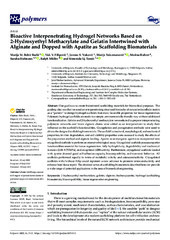Приказ основних података о документу
Bioactive Interpenetrating Hydrogel Networks Based on 2-Hydroxyethyl Methacrylate and Gelatin Intertwined with Alginate and Dopped with Apatite as Scaffolding Biomaterials
| dc.creator | Babić Radić, Marija M. | |
| dc.creator | Filipović, Vuk V. | |
| dc.creator | Vuković, Jovana S. | |
| dc.creator | Vukomanović, Marija | |
| dc.creator | Rubert, Marina | |
| dc.creator | Hofmann, Sandra | |
| dc.creator | Müller, Ralph | |
| dc.creator | Tomić, Simonida Lj. | |
| dc.date.accessioned | 2022-09-15T11:20:10Z | |
| dc.date.available | 2022-09-15T11:20:10Z | |
| dc.date.issued | 2022 | |
| dc.identifier.issn | 2073-4360 | |
| dc.identifier.uri | http://TechnoRep.tmf.bg.ac.rs/handle/123456789/5201 | |
| dc.description.abstract | Our goal was to create bioimitated scaffolding materials for biomedical purposes. The guiding idea was that we used an interpenetrating structural hierarchy of natural extracellular matrix as a “pattern” to design hydrogel scaffolds that show favorable properties for tissue regeneration. Polymeric hydrogel scaffolds are made in a simple, environmentally friendly way without additional functionalization. Gelatin and 2-hydroxyethyl methacrylate were selected to prepare interpenetrating polymeric networks and linear alginate chains were added as an interpenetrant to study their influence on the scaffold’s functionalities. Cryogelation and porogenation methods were used to obtain the designed scaffolding biomaterials. The scaffold’s structural, morphological, and mechanical properties, in vitro degradation, and cell viability properties were assessed to study the effects of the preparation method and alginate loading. Apatite as an inorganic agent was incorporated into cryogelated scaffolds to perform an extensive biological assay. Cryogelated scaffolds possess superior functionalities essential for tissue regeneration: fully hydrophilicity, degradability and mechanical features (2.08–9.75 MPa), and an optimal LDH activity. Furthermore, cryogelated scaffolds loaded with apatite showed good cell adhesion capacity, biocompatibility, and non-toxic behavior. All scaffolds performed equally in terms of metabolic activity and osteoconductivity. Cryogelated scaffolds with/without HAp could represent a new advance to promote osteoconductivity and enhance hard tissue repair. The obtained series of scaffolding biomaterials described here can provide a wide range of potential applications in the area of biomedical engineering. | sr |
| dc.language.iso | en | sr |
| dc.publisher | MDPI | sr |
| dc.relation | info:eu-repo/grantAgreement/MESTD/Basic Research (BR or ON)/172026/RS// | sr |
| dc.relation | info:eu-repo/grantAgreement/MESTD/Basic Research (BR or ON)/172062/RS// | sr |
| dc.rights | openAccess | sr |
| dc.rights.uri | https://creativecommons.org/licenses/by/4.0/ | |
| dc.source | Polymers | sr |
| dc.subject | 2-hydroxyethyl methacrylate | sr |
| dc.subject | alginate | sr |
| dc.subject | biocompatibility | sr |
| dc.subject | gelatin | sr |
| dc.subject | hydrogel scaffolding biomaterials | sr |
| dc.subject | hydroxyapatite | sr |
| dc.subject | tissue regeneration engineering | sr |
| dc.title | Bioactive Interpenetrating Hydrogel Networks Based on 2-Hydroxyethyl Methacrylate and Gelatin Intertwined with Alginate and Dopped with Apatite as Scaffolding Biomaterials | sr |
| dc.type | article | sr |
| dc.rights.license | BY | sr |
| dc.citation.issue | 15 | |
| dc.citation.rank | M21~ | |
| dc.citation.spage | 3112 | |
| dc.citation.volume | 14 | |
| dc.identifier.doi | 10.3390/polym14153112 | |
| dc.identifier.fulltext | http://TechnoRep.tmf.bg.ac.rs/bitstream/id/12835/bitstream_12835.pdf | |
| dc.identifier.scopus | 2-s2.0-85137114845 | |
| dc.identifier.wos | 00083907280000 | |
| dc.type.version | publishedVersion | sr |

